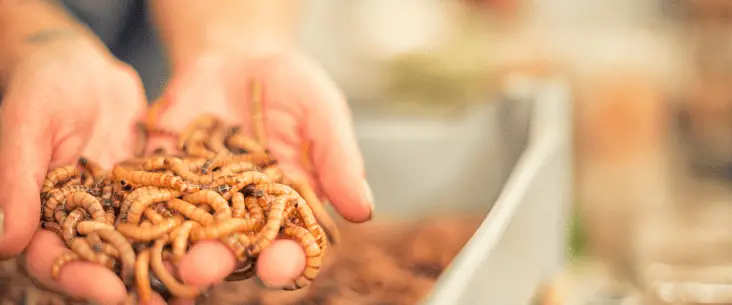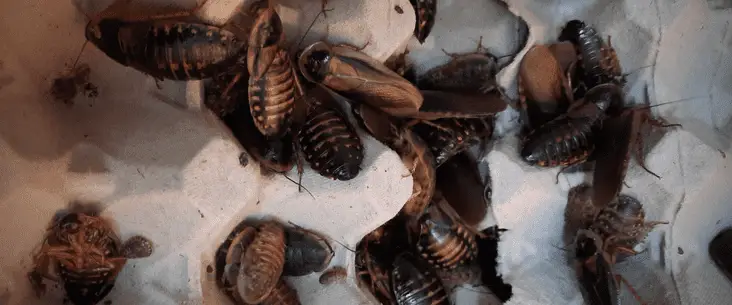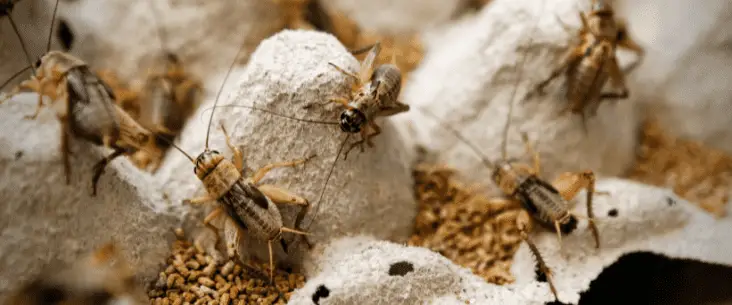Fruit flies are the perfect food source for many exotic pets. You can feed frogs, (young) mantises, small spiders, and many other amphibians and reptiles with fruit flies. They make the perfect food source, not only nutritional but also to stimulate hunting behaviours. You can buy fruit flies in specialized pet shops or at the online store. But when you found this article, you probably considered breeding them yourself. Well, let me tell you: if you follow this guide, it is rather easy to breed your own fruit flies.
To breed fruit flies at home, you only need small 500ml plastic containers, place a nutritional food mix media on the bottom, add some natural wood wool on top, and add around 30 fruit flies to each container. Depending on the fruit fly species, within 12-20 days, you have tripled to tenfold the number of fruit flies.
Although there are fruit fly breeding kits available, you can also breed them easily with the stuff you can get in a supermarket and the tools at home. If you make a good system and keep to the schedule, you never have to buy fruit flies yourself. You could even breed so many fruit flies you can sell them yourself. With this guide, I show you how easy it is to breed fruit flies at home.
What you need for breeding fruit flies
The following supplies are needed to start your fruit flies breeding cultures:
- Plastic containers (with lids): between 400ml (14 oz) and 1000ml (32 oz) in size.
- Paper tissues, nylon net or nylon sheer socks (with nylon use rubber bands)
- Wood wool
- Scissors
- Fruit fly culture: Drosophila hydei or Drosophila melanogaster with an underdeveloped wing mutation that makes them unable to fly. You can order your starter fruit flies online or in a specialized pet shop.
There are two food mixes that have worked for me and have high breeding results. Depending on the availability of products you could choose one of them, or test both out.
Foodmix 1
For approx. 8 breeding containers
- 1.5 litre Water
- 500 grams Oats
- 150 grams Gelling sugar
- 5 spoons White wine vinegar
- 5 Bananas
Foodmix 2
For approx. 8 breeding containers
- 500ml beer (the cheapest)
- 200 grams Dry mashed potato powder
- 100 ml White wine vinegar
- 1 spoon yeast powder

Prepare breeding containers
I prefer to use a larger plastic container of around 700 ml to 1000 ml (24 oz – 32 oz). I think it’s easier to work with. Take the lid of the container. When you use nylon nets or nylon sheer socks, you don’t need the lid. You can place the nylon over the container and attach it with rubber bands.
With paper tissue (you can also use this with nylon), you cut a circular hole in the lid. Don’t cut the hole too big; leave a 1cm around the edge. Then place the paper tissue or nylon between the lid and the container cup. The hole (or nylon net) provides fresh air for your fruit flies without them escaping.
I prefer the method with the nylon net. It is easier to open the container without the fruit flies to escape, especially when you want to feed them to your pet animals.
Prepare fruit fly media
The food mix is important for a proper breeding result. The food mix quantity stated above is for filling around 8 breeding containers. You can adjust the quantities of the ingredients so you can fill more or fewer containers.
Prepare foodmix 1
This food mix is boiled, killing most if not all fungus and bacteria before adding the fruit flies to the container. This way, you have less chance that fungus will grow.
- Mash 5 bananas;
- Fill a saucepan with the 1.5 litres of water and heat up until it boils;
- Add 500 gram of oats to the water while stirring;
- Add 150 gram of gelling sugar to the mix while stirring;
- Add 5 spoons of white wine vinegar to the mix while stirring;
- Add mashed bananas to the mix while stirring;
- Keep stirring until it is a uniform mix;
- Let the mix cool down to room temperature.
Prepare foodmix 2
- Use a large bowl and add 500ml of cheap bear and 200 gram of mashed potato powder;
- Stir it until it is a uniform mix;
- Add 100ml of white wine vinegar to the mix while stirring;
- Keep stirring until the mix is smooth and uniform;
- Add water when it is too dry, add more potato powder when it is too liquid;
- Add 1 small spoon of yeast powder to the mixture and mix it.
Add mixture to the containers
When the mixture of choice is ready, you can scoop an evenly part of the mixture in every container. You should have filled the bottom with around 2cm of the food media (depending on the size of your container).
After filling the container with the food, you place some wood wool on top of the mixture. The wood wool creates more surface for the flies to sit on and prevents them from drowning in your mixture. It can be that the mixture will liquefy a bit more when time passes.
The wood wool also prevents fruit flies from immediately climbing out when opening the lid. But more on that later on.
Start your fruit fly breeding cultures
Now your containers are ready to start your fruit fly breeding cultures. You use the starter fruit fly colony to add some fruit flies to every container. You should add around 15 to 30 flies to every container.
Now you should be well prepared so that not all fruit flies will walk out your new containers or your starter container. So first read the complete step-by-step before take any action. Speed is of the essence in this case.
- Open the new container and keep the lid/nylon net close by to close off quickly;
- Take the container with the fruit flies;
- Tap multiple times firmly on a hard surface, so all the fruit flies fall onto the bottom;
- Between tapping open the lid (partly) of the container;
- While tapping keep the container tilt the container to one side so all fruit flies will fall onto one side/one corner;
- Shake quickly around 15 to 30 fruit flies into the new container and immediately tap afterwards to get the rest of the fruit flies back to the bottom;
- Quickly close the lid of the container;
- Tap the new container quickly and close it off as well.
When doing it this way, the probability that a fruit fly escape is reduced to a minimum. Now, the fruit flies can start breeding in your new container.
The fruit fly culture development

When you keep the containers at room temperature or just above (around 20°C-25°C / 68°F-77°F), the fruit flies will quickly start laying eggs in the food media. The development will be higher with higher temperatures. Never keep fruit flies below 15°C / 59°F: it stops the development, and they won’t lay that many eggs. Humidity around 60% would be best.
Fruit flies have a rather short development cycle, as shown above. That is why they can become a pest rather quickly in your kitchen. When kept at around 25°C / 77°F, the total development of new fruit flies will take around 2 weeks. Larger sized fruit flies will take a bit longer. Often you see many orange/brown pupae around day 11/12.
After two weeks, the food media will be quite dry, and most of it will be eaten by the larvae and new fruit flies. If you are not feeding those fruit flies any time soon (i.e. within days), you should provide some moist food like a piece of banana. Otherwise, the adult fruit flies will die before feeding them.
Now you can use these new adults to start new breeding cultures. That makes the cycle complete, and you won’t need to buy new fruit flies anymore.
Additional tips & tricks
- Set your fruit fly containers in water — A good practice tip is to set the breeding containers on a plate with a small layer of water. It prevents fruit flies that may escape from investing the room where the containers are kept. It also prevents for other organisms to reach your breeding containers.
- Place fruit fly traps around breeding cultures — Place some fruit fly traps around the place where you keep the container. You don’t want wild fruit flies to be attracted and become a pest around your containers. Also, there is a possibility that wild fruit flies will cross-breed with your wingless fruit flies. This way, it may that a few generations further down the line where your fruit flies regain the ability to fly again.
- Be careful with overcrowding — Never place too many fruit flies in one container at the start. They will multiply pretty fast, and overcrowding will negatively affect your fruit fly culture. If you have too many fruit flies in one container, you should split them into two containers. Even with a larger plastic container, never place more than 30 fruit flies into it at the start.
- Avoid direct sunlight — Direct sunlight will negatively impact your breeding colony, mostly by overheating. Keep your fruit flies at a steady temperature but provide them with ambient light/artificial light in a 12H:12H light cycle.
Want to breed other feeder insects yourself?
Check out our other feeder insects breeding guides, so you can easily breed your own feeder insects at home!
– Feeder Locusts Breeding Guide
– Feeder Crickets Breeding Guide
– Feeder Superworm Breeding Guide
– Feeder Springtail Breeding Guide
– Feeder Dubia Roaches Breeding Guide
Share this page!



